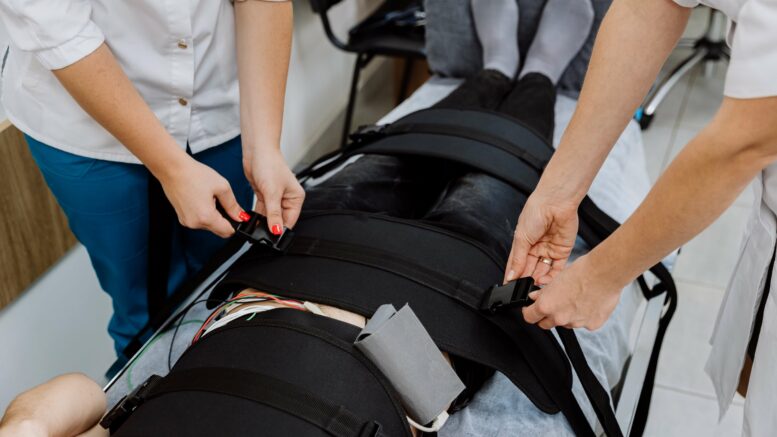The Role of Medical Straps in Patient Care
In healthcare, every detail matters — especially when it comes to patient safety, comfort, and recovery. Medical straps are often small components in the bigger picture of care, but they play an essential role in hospitals, clinics, and rehabilitation centers.
Whether used to secure a patient during surgery, assist in mobility, or support rehabilitation exercises, medical straps must be carefully designed for both function and safety. As a contract manufacturing company with decades of sewn goods experience, we’ve seen firsthand how a well-designed strap can outperform off-the-shelf solutions — and how custom design opens new possibilities for healthcare providers.
1. Common Applications of Medical Straps
Medical straps appear in nearly every area of patient care. Some of the most common uses include:

Surgical Positioning Straps – Keep patients in the correct position during operations or imaging procedures.
Patient Restraint Straps – Provide secure, adjustable restraint in transport or emergency care situations.
Rehabilitation Straps – Used in physical therapy to improve mobility, strength, and range of motion.
Lifting and Transfer Straps – Aid in safe patient handling and reduce strain on caregivers.
Mobility Aid Straps – Found on walkers, wheelchairs, and other assistive devices.
Each of these categories has unique performance requirements, which makes material selection and construction critical.
2. Why Material Choice Matters
The performance, comfort, and durability of a medical strap all start with the right material. Common choices include:
- Nylon Webbing – Strong, durable, and resistant to wear; ideal for load-bearing applications.
- Polyester Webbing – Offers excellent UV and moisture resistance; often used in straps that require long-term durability.
- Polypropylene Webbing – Lightweight and resistant to many chemicals; useful for disposable or semi-disposable applications.
- Specialty Medical Webbing – May include antimicrobial treatments, flame resistance, or FDA-compliant coatings.
When developing a custom medical strap, factors such as tensile strength, flexibility, patient comfort, cleaning requirements, and regulatory compliance all influence the final material choice.
3. Custom vs. Off-the-Shelf Medical Straps
Off-the-shelf straps can work for some applications — but in the medical space, a tailored solution often performs better:
- Better Fit for the Application – Custom straps can match specific equipment dimensions, patient sizes, or therapy needs.
- Enhanced Patient Comfort – Adjustments to width, padding, or closure type can improve patient compliance and reduce discomfort.
- Integration with Existing Devices – Custom designs can be engineered to work seamlessly with hospital equipment or rehabilitation tools.
When you develop your own strap design, you’re not limited by the constraints of mass-produced products — and you gain control over performance, durability, and aesthetics.
4. A Real-World Example: Custom Rehab Strap Development
A local hospital approached us with a challenge: their post-shoulder-surgery rehab program used a commercially available strap that wasn’t quite right for their therapy routines. Patients struggled with grip comfort, and therapists wanted more control over resistance and movement range.
Working closely with their rehab team, we helped refine the design — modifying length, handle style, and attachment points. The result was a strap tailored exactly to their rehabilitation protocol. Today, we manufacture hundreds of these straps annually, helping patients recover more comfortably and effectively.
5. Design Considerations for Your Own Medical Strap
If you’re considering developing a medical strap for your facility or product line, keep these factors in mind:
- Intended Use – Is the strap for restraint, support, therapy, or transport?
- Load Requirements – How much force or weight must the strap withstand?
- Patient Comfort – Will it be in direct skin contact? Does it need padding or softer edges?
- Adjustability and Hardware – Buckles, hook-and-loop fasteners, or cam locks each offer different benefits.
- Cleaning and Sterilization – Materials must handle the hospital’s cleaning protocols without degrading.
- Regulatory Compliance – Consider FDA, ISO, or other healthcare-related standards.
The Value of a Well-Designed Medical Strap
Medical straps may be a small part of your overall equipment setup, but their design can significantly impact patient care, safety, and staff efficiency.
As a contract manufacturer, we’ve partnered with healthcare providers to transform simple ideas into durable, compliant, and patient-friendly products. Whether you’re in the early stages of designing a new strap or refining an existing one, we can help you select the right materials, prototype efficiently, and scale production to meet your needs.
If you’re exploring options for a custom medical strap, contact us to discuss your design and material requirements.

